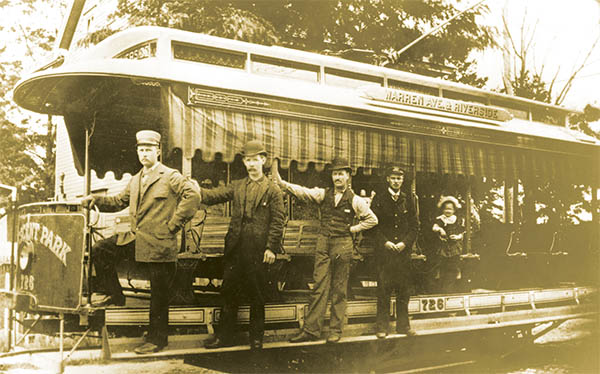END OF THE LINE: The Tracks That Shaped Our RI Streetcar Suburb

Independent Historical Transit Documentary
Featured on RIPTA Website
Film Chronicles the Growth of Edgewood in
Cranston at The Turn of the Century
Providence, Rhode Island, November 15, 2022 – When residents who live along Narragansett Boulevard in Cranston asked the City to fix the potholes that plagued their street several years ago, they did not know that the resulting road work would unearth a chapter of public transit history. It turned out the road was pothole prone because beneath the pavement lay half a mile of steel tracks that once carried the Eddy Street-Edgewood trolley line – a connection that spurred the growth of the popular Edgewood residential neighborhood.
The story is told in an independent film, called END OF THE LINE: The Tracks That Shaped Our RI Streetcar Suburb, which is being featured on homepage of the Rhode Island Public Transit Authority (RIPTA) website at
https://www.ripta.com/endoftheline/
RIPTA is not affiliated with the film that was created by filmmaker and anthropologist David A. Goldenberg.
“This documentary provides an insightful and engaging look at how trolleys and streetcars shaped the growth of the Edgewood neighborhood and is a reminder that public transportation still plays a key role in where people choose to live and where businesses can flourish in our State,” said Scott Avedisian, RIPTA’s Chief Executive Officer. “It also contains many entertaining details of life in Rhode Island at the turn of the century.”
Goldenberg, who lives in Edgewood along the old trolley line, said the project was a labor of love that occurred by happenstance. He has made dozens of documentaries but wasn’t necessarily looking for a new project when he spied the rails in the potholes that caused traffic to rattle and shake when it passed his home. “At a community meeting where City officials announced plans to repave the Boulevard, I realized that they were not even aware of the presence of the tracks, but I convinced them to remove them. That sparked my curiosity about their origin.”
Goldenberg searched national and regional data sources for images and document, and estimates that it took about a year and a half to finish the film – which is entertaining as well as informative.
Key resources were the publications and collections of URI Professor D. Scott Molloy and the film features historical photographs, old transit schedules, fare charts, excerpts from 1890s trolley guidebooks and even turn-of-the-century songs written about trolleys. The film was a semi-finalist for the 2022 RI International Film Festival.
Goldenberg, who has called the project a labor of love, says he enjoys the fact that the film “shows how a popular neighborhood we love was created by the building of several streetcar lines.” At the same time, it also gives a glimpse of what life was like back then, he said, noting that the research “really revealed the language and the quirks of the period.” He also found it fascinating to consider that if he lived in his house in 1908, every morning the trolley would have started up right in front at 5:42 AM, run every ten minutes through most of the day, and arrived on its final run at 2:12 AM.
The quirks include a thoroughly detailed trolley travel guide, written by Marianna M. Tallman, which sternly warns passengers to firmly affix their hats or risk losing them to a stiff wind or abrupt stop by the engineer. It also includes safety records that chronicle the hazards of the open-air cars, including the story of a male passenger who tried to toss away a cigar butt only to strike a tree with his knuckles and need attendance by a local doctor.
The film starts in the mid-1800s when Edgewood was largely undeveloped – just about 50 houses in low-lying coastal land with a connection to Providence provided by a horse-drawn trolley that traveled Broad Street. The ride from Market Square in Providence to Edgewood, with its popular dance hall at Rhodes On The Pawtuxet, took about 50 minutes. The area was largely seen as recreation area because of its shoreline, two yacht clubs, and boating on the Pawtuxet River.
That all changed around 1892 when the Broad Street line was electrified, and Edgewood began to draw attention as an attractive suburban option with convenient transit for commuting. Interest in the area, which was eventually populated with large, gracious homes, intensified in 1896 when the Eddy Street-Edgewood trolley line began running along Narragansett Boulevard.
Goldenberg remembers watching work crews struggle to extract the old tracks from beneath the boulevard and heard them describe it as the toughest material they ever had to cut. He asked them for some pieces, and then had Providence artist David Karoff create a sculpture from it. Over the past few months, he has been working with the Edgewood Waterfront Preservation Association (EWPA) and the Cranston City mason, Dennis F. Conte, to create a masonry base for the sculpture so it can be erected at the corner of Narragansett Boulevard and Sefton Drive – the “end of the line” of the old Eddy Street-Edgewood line. Next to the sculpture will be a historic marker explaining Edgewood’s trolley roots and routes and providing a link to the film.
A public unveiling ceremony will be held within the next few weeks. In the meantime, people can enjoy the film and learn how their auto-friendly, paved city streets hide the footprint of a long-ago trolley system that shaped where they live today.
“Clearly, electrified mass transit transformed this area,” said Barbara Rubine, President of the EWPA. “What was a mix of farms and resort destinations became a vibrant upper middle-class commuter community.”
